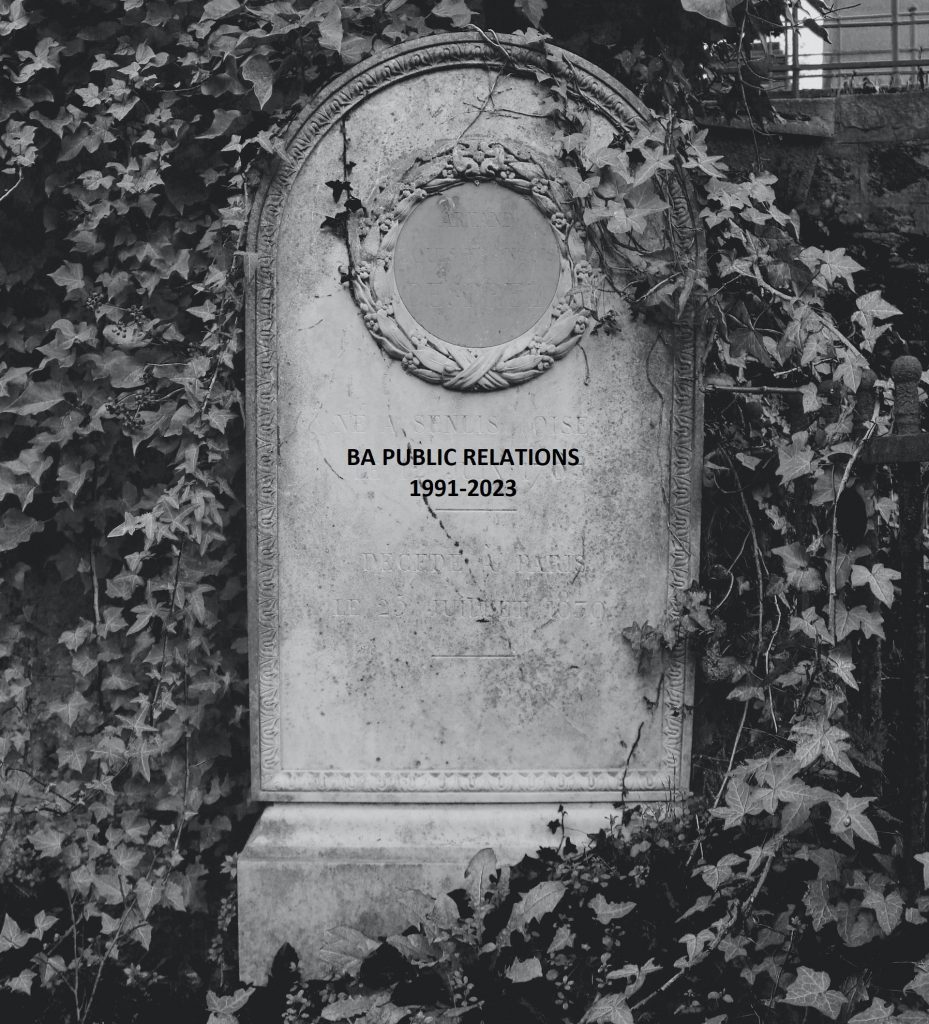Death of a degree – whodunnit?

About the author
Richard Bailey Hon FCIPR is editor of PR Academy's PR Place Insights. He teaches and assesses undergraduate, postgraduate and professional students.

A striking story emerged from the public relations education research report published by PR Academy this month. Nationwide, single honours BA Public Relations degrees are facing extinction.
Many people (including some teaching on these courses) did not see this coming. After all, public relations remains an attractive graduate career route. A degree course offering near 100% employability is surely attractive to universities competing for student fee income and being ranked on just such metrics. It’s also surely attractive to students looking for a return on their investment in a university degree.
Yet the evidence is clear. Our report charted the decline from 22 such degree courses offered two decades ago to just two today (you can currently apply to study single honours public relations at London College of Communication or at Ulster University, but nowhere else in the UK).
There’s a long list of universities that once offered public relations education but no longer do so at BA level: Central Lancashire (UCLAN), The College of Mark and St John (Marjon), Edge Hill, Falmouth, Gloucestershire, Greenwich, Lincoln, Liverpool John Moores, Manchester Metropolitan, Robert Gordon, Solent, Sunderland, Teesside, University of West of England and Westminster.
The two universities with the longest track record in undergraduate public relations education – Bournemouth and Leeds Beckett had run these courses since they were polytechnics – now both offer public relations alongside or within marketing degrees, but no longer as a separate degree course.
I have seen the rise and fall of PR degrees firsthand. For ten years I’ve encouraged student content creators through a contest initially known as #bestPRblogs. In that time, we had one outstanding individual who won two years running. Yet no one will follow in Orlagh Shanks’s footsteps: her course at Liverpool John Moores is one that’s stopped recruiting. For the past two years we’ve had undergraduate winners from Solent University. They were among the best – but sadly also among the last from their university. Another two-time winner was Sunderland, where it’s the same story for the undergraduate course.
We’re keeping #CreatorAwards23 alive for a few more weeks but the depth of talent simply hasn’t been there this year. It’s not just that there are fewer public relations students, it’s also that higher fees have led to some perverse incentives. Rather than challenging students to overachieve, the awareness of the cost of higher eduction leads them to focus more intently on assignments and grades and ignore less quantifiable extracurricular activities.
So whodunnit? Who killed PR degrees? The long list of names given above shows it’s a nationwide pattern, so we can’t lay the blame at the door of individual deans, vice-chancellors, professors or lecturers.
In a recent PRmoment podcast ‘What happened to PR degrees?‘, Bournemouth Principal Academic Tasos Theofilou blamed the higher fees introduced by the coalition governement after 2010. Yet student numbers overall continued to rise despite the increased fees and loans. Surely a degree with high employability would be well placed to survive the new regime? His argument is that higher fees encouraged applicants to choose what they knew, or thought they knew, (whether business, marketing or journalism) over a risky unknown like public relations.
Certainly, the timing looks right. Public relations degree courses that were recruiting strongly in the first decade of this century have been in steep decline since 2010.
Does it matter? There’s certainly a logic to teaching public relations within a broader context. While depth is expected from any degree course, an undergraduate programme (which still primarily recruits among 18 year old school leavers) must also offer breadth. What use is public relations if taught in isolation from its context within business, the media, politics, and society and unless it draws on separate disciplines such as psychology?
Some have long argued that public relations is better suited to postgraduate than to undergraduate degrees on the grounds that those with more life experience will gain more from their studies, and recognising that public relations is an excellent conversion course for those who have gained a BA in a less obviously applied discipline (such as English Literature) and who are looking to boost their employability.
Certainly, postgraduate public relations degree courses continue to recruit strongly so the threat of extinction currently applies only to BA courses. Yet the growth at PG level is from international students and the driver appears to be the attractiveness of a UK student visa (almost 500,000 of these were issued in the year to June 2022). So the strength of these courses as graduate conversion courses for home students is less apparent when you look at the statistics. It also leaves universities vulnerable to decisions within the Home Office. If tighter restrictions were to be placed on student visas, then many of these courses would not be viable given the low numbers of home students they recruit.
Some employers have already lamented the disappearance of PR students; others may say they were never that impressed and are happy to recruit and train graduates from any discipline.
I think the biggest concern lies with those with a vested interest in the public relations professional project. If universities see public relations as a part of marketing; if employers have no issue with this; then the question becomes: why bother joining CIPR and/or PRCA? Why not simply join CIM instead?
Students and new graduates may never have been a major source of new members for the professional bodies, but they should be viewed as potential future recruits. The CIPR and the PRCA have made attempts to address the problem of how to present public relations to those of school age who will never have studied it. They came together ten years ago to produce a joint guide to Careers in Public Relations. The PRCA has also championed apprenticeships as an alternative route for school leavers and the CIPR offers the A-level equivalent Foundation Award.
Degrees are not the only route and the PR Academy research showed there were more people enrolled on public relations professional qualifications in the UK last year than on undergraduate and postgraduate PR degrees combined. So the public relations professional project looks to be alive and well; nor is all public relations education in decline.
Yet some will mourn the passing of public relations degrees after three decades. Not least the hundreds of graduates from these courses, many of whom have gone on to achieve notable success in the field. And also the many practitioners and CIPR members who have cause to thank an academic like Professor Anne Gregory who has taken a prominent leadership position in the profession (she was president when the then IPR was granted its Royal Charter in 2005). Others will be grateful for books such as her Planning and Managing Public Relations Campaigns and others in the PR in Practice series written more for practitoners than for students.
Then there’s the paradox that public relations scholarship is flourishing (the recent 500-page Public Relations Theory III reviewed here shows how large and global the field now is). But how sustainable is the academic publishing model if there are fewer students taking public relations courses? How long will universities fund professorships and readerships in the face of diminishing income from student fees?
An answer may be to reposition the academy away from universities and closer to the professional associations. Perhaps the Academy of Marketing is a model to follow. Perhaps PR Academy hints in its name at the model for our sector.
Within universities, here are two suggested ways forward that could secure the future of public relations degrees.
At BA level, I would argue for a much broader, integrated first year after which a student would choose which specialism to follow. This would ensure breadth as well as depth over a typical three year course, and would mean that everyone would be making choices from a position of knowledge. I’m confident that within one year many would-be journalism students would conclude that public relations was a more future-proof option and many would-be marketing students would choose the greater creativity and challenge presented by public relations.
At postgraduate level, it’s hard to turn down the current demand from international students. So let’s get better at meeting their needs and let’s welcome the diversity they bring to the course. But alongside a one-year MA designed primarily for their needs, universities could offer a two-year part-time MA or MSc programme that would be more appealing to home students looking to combine study alongside work or caring responsibilities.


